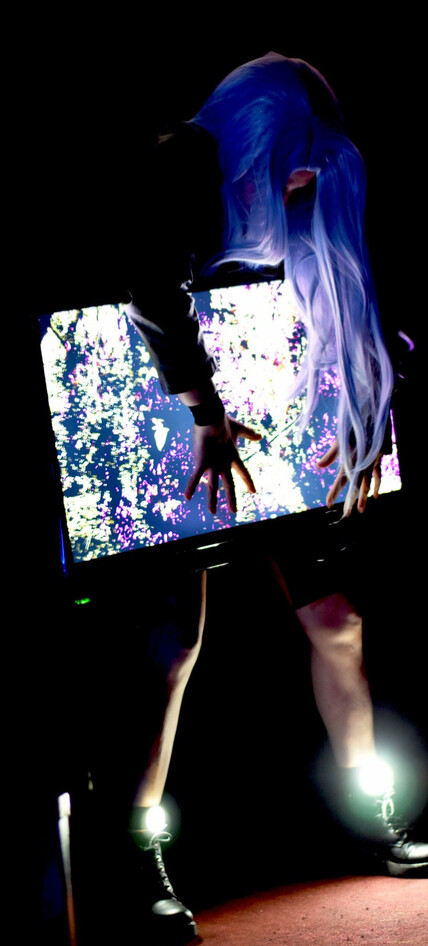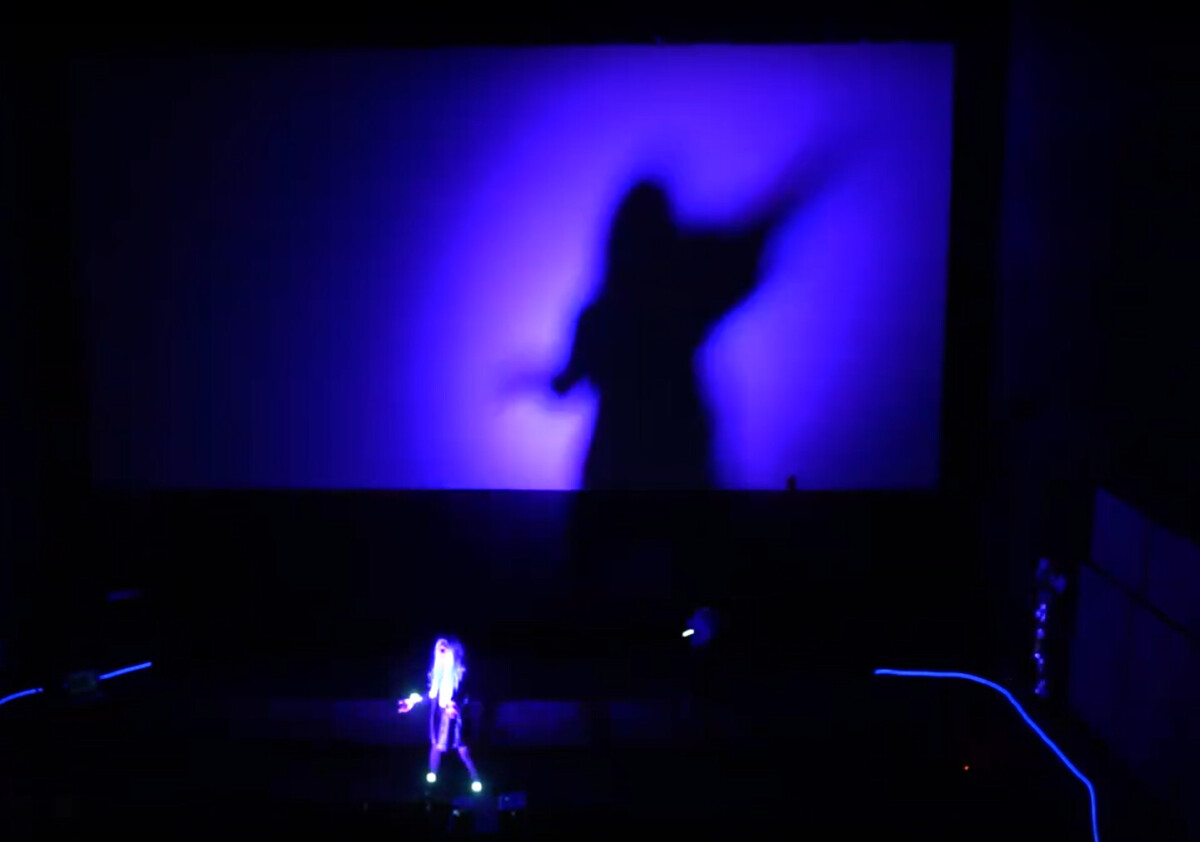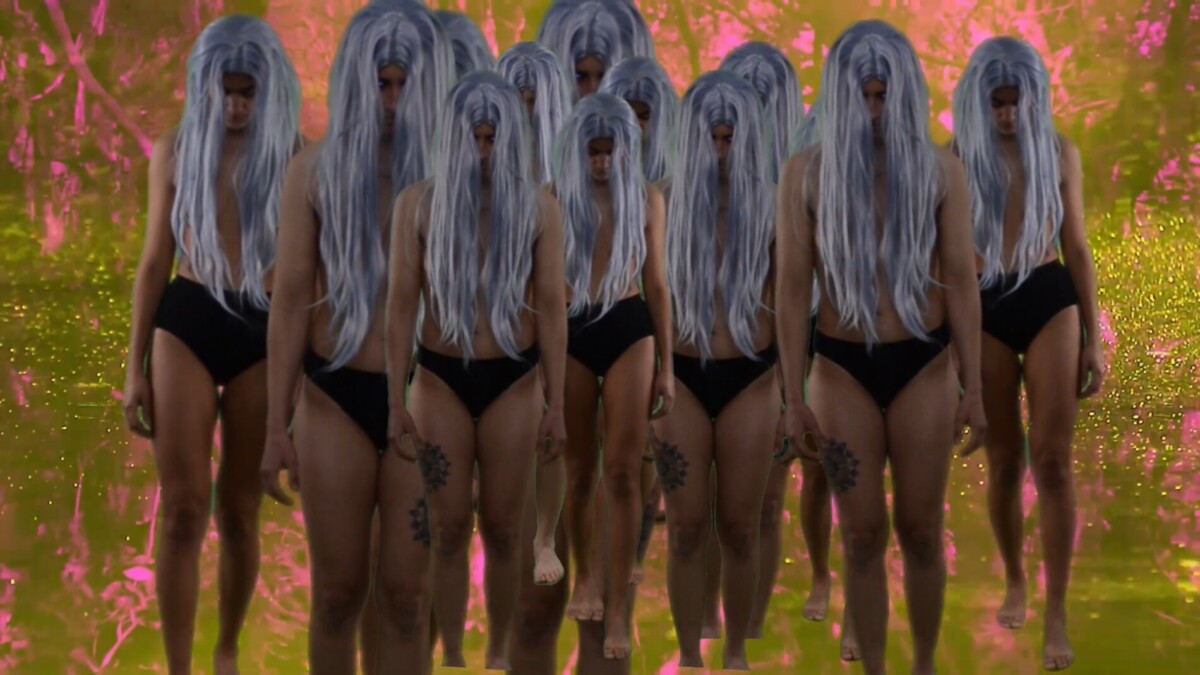Ficticia, prácticas en delay. Dirección artística: Paola Escotto y Noel Rosas. Performers presenciales: Lucía Sismondi, Natalia Burgueño, Noel Rosas y Paola Escotto. Performer virtual: Victoria Colonna. Realizadoras audiovisuales: Clara Fernández y Diego Peña. Operadora audiovisual y de sonido: Fernanda Piñeirúa. Animación y Arte Digital: Mauro Cosenza. Diseño de iluminación: Lucía Acuña. Operadora de luces: Lorena Maneiro. Diseño sonoro: Diego Peña y Mauro Cosenza. Diseño gráfico: Clara Fernández. Gestión y dramaturgia: Noel Rosas y Paola Escotto. Coreografía: Paola Escotto, Noel Rosas y Clara Fernández. Dramaturgismo: Natalia Burgueño. Producción: Lucía Sismondi. Creación y producción general: Colectivo Back to Back. Función: 18 de agosto, Cine Universitario, Montevideo, Uruguay. Próximas funciones: Domingo 1 de septiembre | 19:00 hs. | AUDITORIO NELLY GOITIÑO, Montevideo, Uruguay.
Blurring the lines between the artificial and the organic, this multimedial piece finds a shelter in the body of the screen.
On multiple screens, there is a forest. We barely perceive a slow pan of the camera, and it’s clear why this piece must take place in a cinema screen. Although it’s not the only screen; what first catches the eye is this overflow, screen after screen, screen upon screen, the forest is filled with screens, the cinema becomes a forest. Projectors, cell phones and computers form an ecosystem inhabited by techno-organic beings (Clara Fernández, Noel Rosas, Victoria Colonna and Paola Escotto) that wander through the stage with long white hair and lights on their joints and nipples. Walking in and out of the screens, the flat image gives them a different dimension. At the same time, we see them operating the screens, cameras, and texts. Some of them sit beside us, operating from the cinema seats. There seems to be a clear intention to make explicit every movement generated by contact with technology, to reveal every technical device in its relationship rather than trying to hide its mediation: if everything is on stage, there are no means to an end, everything is an end in itself. The way it differs from the logic of spectacle and technological gimmicks is that multimedia art ultimately seeks to bring the value of a medium as an end, the (un)mediated.
It is an infinite, fractal search for technology and poetry, because even though the characters on stage are visibly playing with lights instead of having someone hidden in the booth, there is always another technology hidden and supporting the development of those in the foreground.
The piece continues to find different ways to create images. It’s not just the cinema overflowing from the main screen to other ones, but also making a screen of just light and shadow, a throwback to probably one of the most primitive ways of making an image on a flat surface, and watching it all unfold: from the lightsource being cut by this elfish creatures to their shadows projected on the cinema screen. Watching the process itself returns a tangible relationship to the act of projection that further closes the gap between seeing and touching.
We usually think of seeing as a diagram of EYE – OBJECT, but that’s always an escape away from sight’s perspective, an attempt to make it understandable only from a linear perspective, when sight is a process that is itself transformed through different perspectives as a way of interacting and understanding the world at the same time.
When we look at a screen, there’s a point where the body becomes screen, and a film cut is felt throughout the entire world. Ficticia… brings multiple screens and makes our eyes change from perspective to perspective, seeing the cinema screen; to seeing the far away, smaller screens, to seeing live performers, then taking them back to the screen via live recording, to finally asking us to take our phones and with a quick modification have small holographic images right in our hands.
However, watching a performer play with its shadow brings back the linear relation: light/performer/shadow-screen. But the play is always within and between screens, it’s not a top-down analytic view of the circuit but a surface-to-surface touch. The relation is that of touch with sight, the light embraces the performer and the screen is their witness: the screen is touched. The relationship reveals that light, and the gaze itself, is action.
Choosing what to watch is the audience’s visual sovereignty, and our duty is to keep creating visual narratives in the continuous escape from the manipulation of a closed circuit.
***
A scenic performance that’s created to be represented on movie theaters, Ficticia: prácticas en delay (loosely translated Fictitious: Delayed practices) is part of the Back to Back collective, where the performers/technicians “explore the poetics, aesthetics, and politics of the body in connection with other bodies and technological media on stage, as well as the relationships between conviviality and techno-conviviality across multiple screens.” (Back to back collective).
The uruguayan collective begins in 2015 with the scenic investigation for PLUG (2016), a performance mixing dance and robotics, where the stage becomes a place to compose with both the human and the artificial. In 2017 they got selected for the program Bitácoras del INAE, for their project Skeleton, where they worked with mediation practices between the dance workshops and robotic workshops that were then unfolding.
Ficticia, prácticas en delay starts in the pandemic as a way to find a new touch on the quarantine landscape, and the practices that appear on the stage, come out of an investigation looking to see in which ways can the human and the screen talk to one another, recognizing a conviviality that’s been here since long ago.
“Embodied fictions in composted humanities that risk blurring presence and virtuality, pixels, animals with synthetic hair, and choreographed vegetations on screens questioning multiplicity, time, and effect. A reservoir of metadiscursive archives of a cyborg community forging kinship, they become others and embrace machines and offer cosmic illusions to connect. Like many other species, they are building possible shelters.” (Back to back collective).
Ficticia, prácticas en Delay will be presented on Sunday, September 1st, at the Nelly Goitiño Auditorium.
*Main photo: Mariana Pérez
Entre lo artificial y lo orgánico, la obra escénica Ficticia, prácticas en delay encuentra un refugio en el cuerpo de la pantalla.
En varias pantallas, hay un bosque. Una proyección gigante hace del teatro una sala de cine. El bosque proyectado sufre pequeñas y constantes transformaciones a cada segundo, como cayendo en escalones. La dimensión del bosque nos torna habitantes de la pantalla; la música insiste en una misma línea burbujeante de pequeñas e inquietas texturas que, al igual que el movimiento de la cámara, de forma sutil e infinitamente elastizada, nos torna inmersos en un movimiento de punto de vista. Estamos y nos movemos.
Pero esta no es la única pantalla. Lo primero que llama al ojo es el desborde, pantalla tras pantalla, pantalla sobre pantalla: ahora el cine se torna bosque, bosque de pantallas. Proyectores, celulares, televisores y computadoras forman un ecosistema de puntos de vista, algunos más grandes, más envolventes, y otros que se presentan más envueltos: la pantalla como paisaje y la pantalla como cuerpo; la pantalla como sujeto y la pantalla como objeto.
La sala de cine es habitada también por otro tipo de cuerpos, unos seres anónimos y fotoluminiscentes de largo pelo blanco (Clara Fernández, Noel Rosas, Victoria Colonna y Paola Escotto). Ellas caminan dentro y fuera de las pantallas, las vemos operar lo que allí aparece, las vemos manipular su propia imagen proyectada. Tridimensional y bidimensional, ahora habitan un mismo espacio.
Algunas de ellas están sentadas al lado nuestro, operando desde las butacas; parecería haber una intención de explicitar todo movimiento que se genera a partir del contacto con la tecnología, un intento por hacer que todo dispositivo técnico se devele en su relación con los demás dispositivos en lugar de esconder su mediación: si todo está en escena, no hay medios para un fin, todo es un fin en sí mismo. Así es como se separa esta obra de la lógica del espectáculo y del progreso tecnológico, permitiéndose trazar una búsqueda en el acto de atravesar diferentes medios, y no haciendo de ese movimiento la expresión de un brillo fugaz del avance tecnológico. Lo que busca el arte multimedial, al final, es traer la atención a la materia, el intento, el medio: hacerlo todo un fin. Fin interminable desbordando (in)mediatez.
Ficticia… es una búsqueda infinita y fractal de tecnología y poesía. Porque, aunque sean los personajes quienes están en escena visiblemente jugando con las luces en lugar de tener una persona escondida en la cabina (que también la hay), siempre va a haber otra tecnología que se esconde y apoya al desenvolvimiento de aquéllas que están en primer plano: para iluminar se necesita un foco, el cual tiene en el desarrollo de su creación como tecnología sus requisitos tecnológicos anteriores así como también sus particulares formas de desbordar poesía.
La obra continúa encontrando diferentes formas de hacer imágenes. No es solo el cine que se desborda de la pantalla principal hacia otras pantallas, sino, por ejemplo, un foco de luz que recorta la sombra de uno de estos personajes élficos sobre la pantalla de cine, prácticamente una referencia a lo que quizás sea la forma más antigua de crear imágenes sobre una superficie plana, una especie de proto-cine: observar el desenvolvimiento de la relación fuente de luz – performer – sombra proyectada le devuelve una relación tangible al acto de proyectar, acercándonos más a una noción de tocar con la mirada.
Generalmente, entendemos la mirada como el diagrama ojo – medio – objeto; el problema es que, para eso, tenemos que crear un punto de vista superior a la mirada, separarnos del ojo y mirar tanto lo que mira como lo observado; y de paso, colocarnos precisamente en una posición invisible, objetiva: imagen total de la realidad, punto de vista sin punto de vista. Así, logramos atrapar la mirada, hacer que deje de ser un proceso y se torne cristalizada, comunicable. Pero cuando miramos una pantalla, en la experiencia, el cuerpo propio pasa a ser el cuerpo de la pantalla, y el montaje es un evento que atraviesa el mundo. Ficticia… trae múltiples pantallas y nos obliga a cambiar de perspectiva, montando puntos de vista como si ese cambio fuese el hilo dramático en sí: de un paisaje en la pantalla enorme a pequeñas pantallas, a performers en vivo, a las performers en pantalla. Claro que mirar una performer jugar con su sombra trae una relación lineal (fuente de luz – performer – sombra proyectada), sin embargo, el juego está entre y dentro de cada capa; no es una visión superior y analítica del circuito, sino un toque de superficie con superficie. Es el encuentro del tacto con la visión, la luz abraza a la performer y la sombra es su testigo: la luz tiene cuerpo y la mirada tiene acción.
En el despliegue interminable de formas de inter/acción, Ficticia… continúa desbordando por fuera de la pieza escénica hacia la videodanza, experiencias con mediación explicitada del público, y prácticas de investigación en coreocinema, donde se ubica esta corriente de creadoras. La pieza se encuentra llena de más sorpresas y formas de interactuar que, transformando a la audiencia en espectadores-performers y técnico-poetas, demuestra que la elección sobre el qué mirar es soberanía de la audiencia, emergiendo así como una narrativa visual que se niega a la manipulación del circuito cerrado.
***
El domingo 1ro de septiembre en el Auditorio Nelly Goitiño de Montevideo se presentará la cuarta temporada de Ficticia, prácticas en delay. Una propuesta multimedial uruguaya que combina danza, cine y arte digital en el seno del campo emergente llamado coreocinema.
*Foto portada: Mariana Pérez


